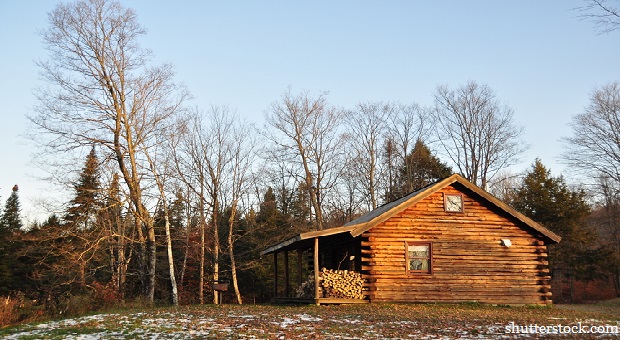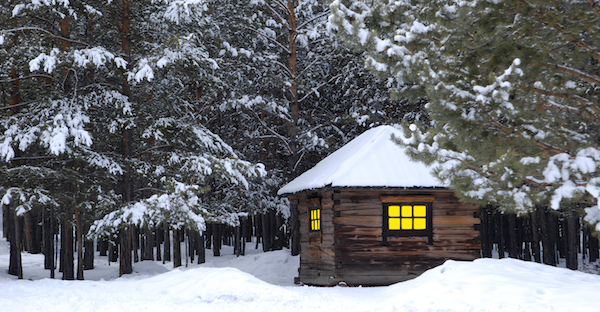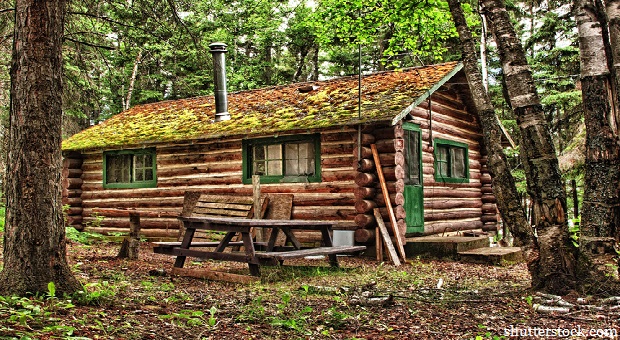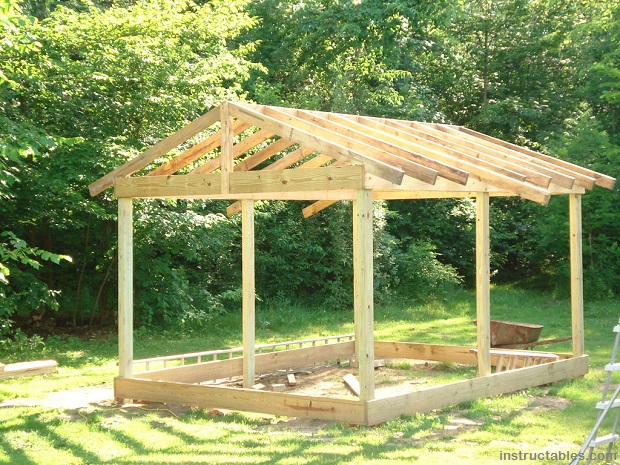Have you ever thought about what you’d do if you were no longer able to live in your primary residence? Maybe you’ve lost your job, there’s a long term power outage, or it’s simply just not safe to live there anymore.
Preppers are usually prepared for a whole host of things, including being able to live out in the open, make temporary shelter, keep warm and feed themselves, but how many of you actually have a prepper shelter to escape to?
A prepper shelter can provide you with a space not just for when SHTF, but in the meantime can be used as a place to hang out, somewhere to go for the weekends or a place to store all your equipment. From shipping containers, to underground bunkers, to a log cabin kit in the forest, these are all great options for a shelter.
However, one of the most common mistakes that Preppers make is putting a load of time, money and effort into building a solid fortress. But realistically, no matter how solid or thick your walls are, if enemies can get close enough to your home to shoot – its game over.
The best way to design your prepper shelter is to choose an area which people can’t reach via car, and have additional security measure around the perimeter. Perhaps the most advantageous place to build such shelter is in a forest or wooded area.
A log cabin makes a perfect prepper shelter for a number of reasons; it can be assembled in just a few short weeks if you choose a kit, it will stand strong and stable for years to come and it blends in well in a wooded environment.
Why choose a log cabin kit?
With over 30,000 kits manufactured each year in the US, there are plenty of reasons why kits are growing in popularity:
- Time
Most people just don’t have the time to build a log cabin from scratch, or access to the number of trees required to build a cabin. Preppers included! This is where a log cabin kit comes in handy. A kit is a perfect alternative for those preppers who like the feel and look of a log cabin but just don’t have the time or experience to dedicate to building one.
Whilst a temporary shelter is initially faster to construct, the longevity of a cabin ensures lifetime build value is much greater with a cabin than a temporary shelter; the temporary shelter will require lots of maintenance and re-builds.
Choosing a kit speeds up the planning process as well as the building process, because the majority of kits are already pre-designed and with hundreds to choose from, you’re bound to find one that suits your needs. The likelihood is that you just want a kit to build a small, off-grid square cabin, and the industry is full of log cabins meeting just those requirements.
- Ease
The beauty of a kit is all the difficult and time-consuming work gets done by the manufacturer, including felling the trees, peeling the logs and drying them. They also scribe and notch the logs together to ensure they fit together perfectly.
There are so many different options for the logs, from the type of wood you choose, to how the corners are joined (notch type), to the profile and finish of the log (for example if you want it hand hewn for a more natural look, or milled for a uniform look).
The materials are then delivered right to your site, and depending on the size of your cabin, it is quite possible to have the cabin up and fully functioning in just a week or two. The logs are already notched and ready to piece together, much like the childhood Lincoln Logs toy, but life-size.
This process is without a doubt easier than building your own prepper shelter from scratch which, again depending on the size, could take a minimum of 6 months.
- Flexibility
Whatever idea you have in your head for the perfect log cabin prepper shelter, it’s pretty likely that there is already a kit which meets those exact requirements, but, if not, most manufacturers are happy to be completely flexible and chop and change parts of the kit to make sure you’re buying only what you need.
There is a huge amount of flexibility, from the species of wood you choose to use, to the notch and finish type.
The most common types of logs used are pine, cedar, cypress and oak. Pine is the most popular and also one of the cheapest options, whereas cedar is considered to be a premium wood and comes with a higher price tag.
The next choice is how to join the logs, the most common notches are saddle-notch, dovetail, corner post and butt and pass. This is mainly down to personal preference as all of these joins produce tight and well fitted joins.
The more obvious flexibility you have in choosing a kit is the size and layout of the cabin. Kits range from 150 square foot, to much larger and luxurious plans, however given the purpose of a survival shelter you’ll most likely want to stick with a smaller cabin both to keep well-hidden and for heating purposes.
- Cost
Whilst the cost of log cabin kit is slightly more expensive than building your own, it is probably on par with other prepper shelters such as underground bunkers and earth-bag homes.
Depending on the level on finish you want, you can expect to pay varying prices.
A ‘shell-only’ package will include the log wall system, and perhaps the roof, this will cost you $50-$80 per square foot.
A ‘dry-in’ package includes all the materials you need to build the exterior of your log cabin. I’d imagine this would be perfect for a prepper cabin as you don’t need fancy interior finishes. This option costs in-between $70-$130 per square foot.
The final option is the ‘turn-key’ package; this includes everything you need to have a cabin that is ready to move in to. From exterior fittings to all the interior fittings, this package is the most expensive of the three and costs in-between $130-$180 per square foot.
As a prepper you probably will be looking for a shell-only package and then using your survival skills to finish the cabin.
- Function Off-Grid
Another benefit of a log cabin is that they have the capability of functioning completely off-grid which is one of the most important elements of a prepper shelter. If the main power supply goes out long term, it’s vital that you have other ways to cook and keep clean and warm.
If you choose a cabin which is not too large in size, you’ll be able to incorporate a chimney, and heat the cabin with a fire. You’ll also be able to use the fire to cook your food.
If you make sure you site your log cabin well, you’ll be close by to a water supply which will provide you with drinking water and water to cook and wash with.
- Blends in Well
As mentioned earlier, one of the huge appeals of living in a log cabin is that they blend so seamlessly into any forest or wood environment. This is important if you want your shelter to go unnoticed and to prevent attracting any unwanted guests.
Whilst it will be visible if someone gets up close to the cabin, there are plenty of diversions you can put in place to prevent people from getting too close. By building in an area of thick growth, people will be less likely to venture through and find you, especially if it looks undisturbed. You might also consider adding additional security measures around the perimeter of the cabin.
- Multiple Use
Building a log cabin doesn’t just have to be for the sole purpose of preparing for the worst, in the meantime it can be used as a whole host of different things.
Depending on its location it can be used as; a weekend getaway to get closer to nature and practice survival skills, a rental property, an annex for older or younger family members or just somewhere to store all your prepper equipment.
Is a log cabin right for you?
If you have a piece of land that you could build a log cabin on, it could make a perfect survival cabin for you and your family when SHTF.
They blend in well with the forest surroundings and provide a sturdy home which will be easy to heat if you keep it small enough.
Would you consider a log cabin kit for a prepper shelter?









William Glass | April 27, 2018
|
What about the problem of forest fires? These happen just by acts of nature . More likely in a SHTF scenario. It would be my luck to put my cabin in an area of “thick growth” and the next day a lightning strike starts a forest fire and my cabin goes up in smoke.
Bill in Idaho | April 27, 2018
|
Hello, David. I like your Article, but you should Strongly Emphasize some critical points: I have worked with timber Most of my life, and some points are just unavoidable. You listed 4 types of logs: pine, cedar, cypress and oak. Pine is the worst of All Conifers, and depending on the Specific Variety or Sub-species of Pine, the Durability and Strength attributes range from passable to terrible. Of All the Conifers, ONLY Fir (Especially Douglas Fir grown above 3000′ msl) can be considered to be optimal. That lets Cedar out, and Redwood, Larch, or Hemlock are Terrible choices. Cypress will drive you buggy trying to find any two logs with similar dia. and taper. Oak is tough and durable, but it is hard to work, and unless you have a large grove of Post Oak, or White Oak, finding uniform logs will be challenging. Hickory or Mountain Ash are fair choices, but hard to find in sufficient quantity. Round Notches (aka Saddle Notching) is the Only way to go – for ease of prep, and for secure, stable walls. Anyone who has built a “Log” Cabin/ House can tell you the Tremendous amount of work involved, and How Many Logs will be needed. Bill
Big D | April 27, 2018
|
So the heading on the email is titled $4,490.00 Log Cabins (For Hunts, Holidays and Bug Outs) yet the article says a dry in starter starts at $70.00 per sq ft so the email heading really should’ve said $4,490.00 for Log Cabin 6 x 10 aprox room without foundation, or anything else? wow .. always more and more it seems the email lead ins either are somewhat deceptive or link to links that are grueling and arduous tasks of repetitive rhetoric before anything possibly of substance is displayed. Shame on your sales and marketing bs . .I’ve got over 30 years building experience incl log homes and really wanted to see what this was all about, wow
Marty | April 27, 2018
|
David, I disagree about how great it is to live in the forest. You mention about someone getting close enough to shoot at your house. I currently live in an Alaskan Style log house in the forest. The bad guys could be behind any of the trees and you would never know it. My horse barn is about 200 feet from my house. I have to go up there at least twice a day to feed. I try to use situational awareness, but it is real difficult with all the trees. Yea, we have several dogs to warn us of “visitors”, but nine times out of ten, it’s usually just the deer. One of your readers mentioned the dangers of wild land fire. The is a very real and present danger for us. As a wild land fire fighter, I’ve been out on large fires when my wife got called to evacuate. Can you imagine the stress of her trying to get all the animals out with me being elsewhere on the fire. After 13 years, we’ve decided it’s time to move. We will be looking for flat farm type land where I can keep most vegetation down and actually live a “firewise” life style. The other problem with owning a log home is the maintenance. The feds have outlawed all products that last for more than a few years. Maintaining a log home is very time consuming and expensive.
michael countryman | April 27, 2018
|
just to let you all know I am going be building a log cabin on my property here soon and it wont be that fake wood that some cabins I have seen .
Bill in Idaho | April 29, 2018
|
David, just an additional note: Log Homes in “Kit” form are not “a little more expensive” – they are as expensive as a “Tract” home, if they are truly Complete. We have over a dozen specialized sawmills in our area building – and selling – “Kit” Log Homes. By the time you pay for trucking and a mobile hydro-crane ($ 7-8,000), you will be in for the big bucks. Better have a rich uncle. Bill
Bill in Idaho | April 30, 2018
|
Hello, David – Bill Again . . . I just remembered one of our local “Custom” sawmills that puts together complete Log Homes (1000 to 1200 Sq Ft) using Only Western Red Cedar (or Pacific Cedar). This variety/ Species is Not a True Cedar – but – It makes for Beautiful Logs. They ain’t cheap, so I did a quick bit of research: Here it is: [ Western Red Cedar -or- Pacific Red Cedar is a Sub-species of “Thuja”, an evergreen (Coniferous) tree – a member of the cypress family “Cupressa aceae” It is native to western North America. It is not a true cedar of the genus Cedrus]. We have some really big stands of this species in Oregon, Idaho, Western Montana, and Southern British Columbia. So you were Not Wrong about listing the Cypress tree. Bill.
Paul Lackey | May 5, 2018
|
Not a really viable idea. If you follow his suggestion of placing your home in really secure forest area, your kit company will ruin that just to deliver the home to your site. Sorry, find better plans to go off grid.
HorseWeb | June 24, 2021
|
I bought a lot in a wooded area in Indiana 10 years ago, built a log cabin, a stable, and I want to note that to this day I am happy with my choice. I haven’t noticed any disadvantages.